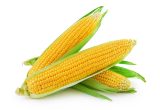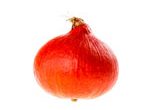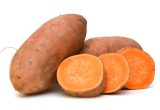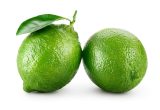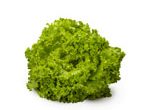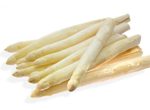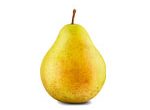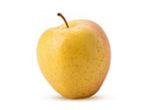Cauliflower

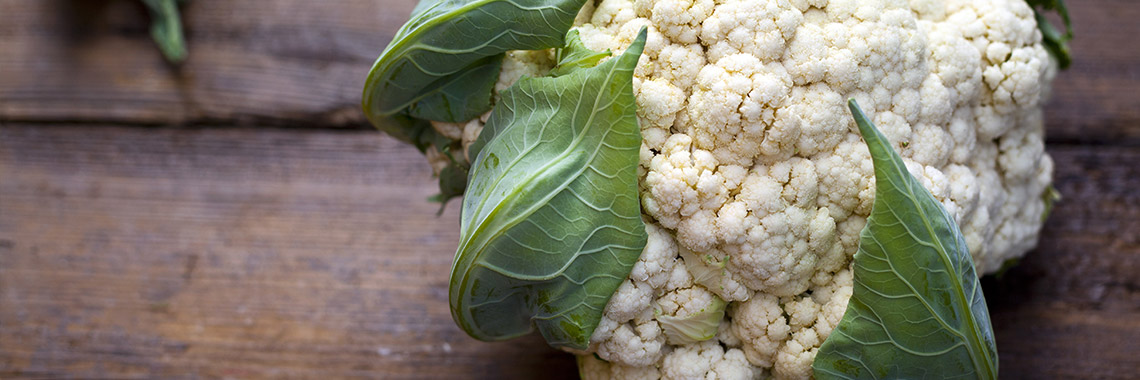
Description
- Cauliflower (Brassica oleraceae var. botrytis) belongs to the Brassicaceae (cruciferous) family.
- Cauliflower is an important crop in India (Dhall, 2010).
PHYSICAL AND ORGANOLEPTIC CHARACTERISTICS
- Cauliflower is cream in colour (Dhall, 2010). This colour can vary depending on the cauliflower genotype. In fact, a rare mutation results in high β-carotene concentration in cauliflower, which changes its colour (yellow, orange) (Li, 2006).
- There is also the purple cauliflower, Graffiti cultivar, which is also the result of a mutation allowing anthocyanin synthesis (Chiu, 2012), and the green cauliflower whose mutation results in the development of chloroplasts, inducing the green-white colour (Zhou, 2011).
- Glucosinolates and their derivatives, isothiocyanates, are sulfur compounds that are thought to be responsible for the bitter taste of Brassica vegetables, of which cauliflower is a member (Wieczorek, 2018).
- These compounds are also thought to contribute to the aroma of cauliflower (Ortner, 2016; Wieczorek, 2018). Isothiocyanates, derived from the degradation of glucosinolate, are reportedly responsible for the pungent odour of Brassica vegetables (Ortner, 2016; Mithen, 2018).
- Brassicadiene, a hydrocarbon of the terpene family, is believed to be the main volatile compound in cauliflower. It is thought to represent more than 90% of the volatile compounds produced by cauliflower (Arriola, 2020).
COMPOSITION CHARACTERISTICS (excluding macronutrients, vitamins and minerals)
- Cauliflower contains significant amounts of antioxidant compounds such as flavonoids that confer health benefits. Consumption of plant products high in compounds with antioxidant activity is associated with a reduction in certain chronic diseases, such as atherosclerosis and cancer (Gonzalez-Fandos, 2016).
- Glucosinolates and their derivatives, isothiocyanates (ITCs), contained in Brassica vegetables are reported to have anticancer properties and reduce the risk of cardiovascular diseases (Mithen, 2018; Wieczorek, 2018).
- Consumption of cruciferous vegetables such as cauliflower is negatively related to the risk of developing breast, stomach, prostate, bladder and lung cancer. This effect is a result of the activity of TKIs present in cauliflower (Sita, 2018).
RAW
The following values are approximate and depend on variety, season, ripeness, cultivation conditions, etc.
Raw cauliflower is low in energy* as it provides an average of 26.20 calories (kcal) per 100 g, i.e. 109 kJ. One cauliflower weighs on average 1.5 kg.
COMPOSITION TABLES
For each nutrient, the tables provide information on the content, minimum and maximum values and the percentage of the Dietary Reference Values (DRVs) per 100 g net of raw cauliflower.
*Regulation (EC) No 1924/2006 of the European Parliament and of the Council of 20 December 2006 on nutrition and health claims made on foods.
MACRONUTRIENTS
| Constituent (g) | Average content |
Min-Max per 100g |
DRV% |
|---|---|---|---|
| Water | 92,9 | 87,50 - 94,70 | - |
| Fibers | 2,20 | 1,70 - 3,40 | - |
| Carbohydrates | 2,13 | 1,69 - 2,50 | 0,82 |
| Sugars | 1,70 | 0,90 - 2,30 | 1,89 |
| Lipids | 0,70 | 0 - NC | 1 |
| Saturated fat | 0,24 | 0 - NC | 1,20 |
| Protein | 1,81 | 0,20 - 4,38 | 3,62 |
| Constituent (g) | Amount | Min-Max | DRV% |
|---|---|---|---|
| Water | Ciqual 2020 (valeur issue des analyses Ciqual-Aprifel 2017) | - | - |
| Fibers | Ciqual 2020 (valeur issue des analyses Ciqual-Aprifel 2017) | - | - |
| Carbohydrates | Ciqual 2020 | - | Règlement (UE) N°1169/2011 du parlement Européen et du conseil du 25 octobre 2011 |
| Sugars | Ciqual 2020 (valeur issue des analyses Ciqual-Aprifel 2017) | - | Règlement (UE) N°1169/2011 du parlement Européen et du conseil du 25 octobre 2011 |
| Lipids | Ciqual 2020 (valeur issue des analyses Ciqual-Aprifel 2017) | - | Règlement (UE) N°1169/2011 du parlement Européen et du conseil du 25 octobre 2011 |
| Saturated fat | Ciqual 2020 (valeur issue des analyses Ciqual-Aprifel 2017) | - | Règlement (UE) N°1169/2011 du parlement Européen et du conseil du 25 octobre 2011 |
| Protein | Ciqual 2020 | - | Règlement (UE) N°1169/2011 du parlement Européen et du conseil du 25 octobre 2011 |
Zoom on fibres
- Raw cauliflower contains 2.20 g of fibre per 100 g, which is lower than the average content of raw vegetables (2.43 g per 100 g).
Zoom on proteins
- The protein content of raw cauliflower (1.81 g per 100 g) is slightly lower than the average content found in raw vegetables (1.87 g per 100 g).
Zoom on carbohydrates
- The carbohydrate content of raw cauliflower (2.13 g per 100 g) is lower than the average content found in raw vegetables (4.45 g per 100 g).
- They are in the form of glucose (0.90 g per 100 g) and fructose (0.80 g per 100 g).
- Raw cauliflower is low in sugar* (1.70 g per 100 g) as it contains no more than 5 g per 100 g.
Zoom on lipids
- Its fat content (0.70 g per 100 g) is higher than the average content in raw vegetables (0.56 mg per 100 g).
- Raw cauliflower is low in fat* as it contains less than 3 g per 100 g.
*Regulation (EC) No 1924/2006 of the European Parliament and of the Council of 20 December 2006 on nutrition and health claims made on foods.
MINERALS AND TRACE ELEMENTS
| Constituent | Average content |
Min-Max per 100g |
DRV% |
|---|---|---|---|
| Calcium (mg) | 23 | 21 - 29 | 2,88 |
| Chloride (mg) | 25,40 | - | 3,18 |
| Copper (mg) | 0,02 | NC - 0,073 | 2 |
| Iron (mg) | 0,27 | 0,24 - 0,70 | 1,93 |
| Iodine (µg) | < 20 | 0,10 - NC | - |
| Magnesium (mg) | 9,80 | 5,15 - 17,40 | 2,61 |
| Manganese (mg) | 0,14 | 0,13 - 0,39 | 7 |
| Phosphorus (mg) | 40 | 38,90 - 56,70 | 5,71 |
| Potassium (mg) | 270 | 189 - 375 | 13,50 |
| Selenium (µg) | < 20 | 0,40 - NC | - |
| Sodium (mg) | 6 | 4,10 - 55 | - |
| Zinc (mg) | 0,22 | 0,16 - 0,49 | 2,20 |
| Constituent | Amount | Min-Max | DRV% |
|---|---|---|---|
| Calcium (mg) | Ciqual 2020 (valeur issue des analyses Ciqual-Aprifel 2017) | - | Règlement (UE) N°1169/2011 du parlement Européen et du conseil du 25 octobre 2011 |
| Chloride (mg) | Ciqual 2020 (valeur issue des analyses Ciqual-Aprifel 2017) | - | Règlement (UE) N°1169/2011 du parlement Européen et du conseil du 25 octobre 2011 |
| Copper (mg) | Ciqual 2020 (valeur issue des analyses Ciqual-Aprifel 2017) | - | Règlement (UE) N°1169/2011 du parlement Européen et du conseil du 25 octobre 2011 |
| Iron (mg) | Ciqual 2020 (valeur issue des analyses Ciqual-Aprifel 2017) | - | Règlement (UE) N°1169/2011 du parlement Européen et du conseil du 25 octobre 2011 |
| Iodine (µg) | Ciqual 2020 (valeur issue des analyses Ciqual-Aprifel 2017) | - | Règlement (UE) N°1169/2011 du parlement Européen et du conseil du 25 octobre 2011 |
| Magnesium (mg) | Ciqual 2020 (valeur issue des analyses Ciqual-Aprifel 2017) | - | Règlement (UE) N°1169/2011 du parlement Européen et du conseil du 25 octobre 2011 |
| Manganese (mg) | Ciqual 2020 (valeur issue des analyses Ciqual-Aprifel 2017) | - | Règlement (UE) N°1169/2011 du parlement Européen et du conseil du 25 octobre 2011 |
| Phosphorus (mg) | Ciqual 2020 (valeur issue des analyses Ciqual-Aprifel 2017) | - | Règlement (UE) N°1169/2011 du parlement Européen et du conseil du 25 octobre 2011 |
| Potassium (mg) | Ciqual 2020 (valeur issue des analyses Ciqual-Aprifel 2017) | - | Règlement (UE) N°1169/2011 du parlement Européen et du conseil du 25 octobre 2011 |
| Selenium (µg) | Ciqual 2020 (valeur issue des analyses Ciqual-Aprifel 2017) | - | Règlement (UE) N°1169/2011 du parlement Européen et du conseil du 25 octobre 2011 |
| Sodium (mg) | Ciqual 2020 (valeur issue des analyses Ciqual-Aprifel 2017) | - | Règlement (UE) N°1169/2011 du parlement Européen et du conseil du 25 octobre 2011 |
| Zinc (mg) | Ciqual 2020 (valeur issue des analyses Ciqual-Aprifel 2017) | - | Règlement (UE) N°1169/2011 du parlement Européen et du conseil du 25 octobre 2011 |
Zoom on minerals and trace elements
- Raw cauliflower provides a significant amount of potassium with a content representing 13.50% of DRVs, i.e. 270 mg per 100 g.
- The most represented trace element in raw cauliflower is manganese with a content equivalent to 7% of DRVs, i.e. 0.14 mg per 100 g.
- The other minerals and trace elements are present in quantities representing less than 6% of DRVs.
VITAMINS
| Constituent | Average content |
Min-Max per 100g |
DRV% |
|---|---|---|---|
| Provitamin A Beta-carotene (µg) | < 5 | 0 - NC | - |
| Vitamin A equivalent (µg) | < 0,83 | 0 - NC | - |
| Vitamin B1 (mg) | 0,031 | 0,02 - 0,13 | 2,82 |
| Vitamin B2 (mg) | < 0,01 | NC - 0,092 | - |
| Vitamin B3 (mg) | 0,26 | NC - 0,75 | 1,63 |
| Vitamin B5 (mg) | 0,72 | 0,60 - 0,75 | 12 |
| Vitamin B6 (mg) | 0,22 | 0,05 - 0,25 | 15,71 |
| Vitamin B9 (µg) | 56,20 | NC - 226 | 28,10 |
| Vitamin C (mg) | 4,14 | NC - 92,90 | 5,18 |
| Vitamin E (mg) | < 0,08 | NC - 0,30 | - |
| Vitamin K1 (µg) | 3,31 | NC - 23 | 4,41 |
| Constituent | Amount | Min-Max | DRV% |
|---|---|---|---|
| Provitamin A Beta-carotene (µg) | Ciqual 2020 (valeur issue des analyses Ciqual-Aprifel 2017) | - | - |
| Vitamin A equivalent (µg) | Calcul à partir de la valeur Provitamine A Béta-carotène* | - | Règlement (UE) N°1169/2011 du parlement Européen et du conseil du 25 octobre 2011 |
| Vitamin B1 (mg) | Ciqual 2020 (valeur issue des analyses Ciqual-Aprifel 2017) | - | Règlement (UE) N°1169/2011 du parlement Européen et du conseil du 25 octobre 2011 |
| Vitamin B2 (mg) | Ciqual 2020 (valeur issue des analyses Ciqual-Aprifel 2017) | - | Règlement (UE) N°1169/2011 du parlement Européen et du conseil du 25 octobre 2011 |
| Vitamin B3 (mg) | Ciqual 2020 (valeur issue des analyses Ciqual-Aprifel 2017) | - | Règlement (UE) N°1169/2011 du parlement Européen et du conseil du 25 octobre 2011 |
| Vitamin B5 (mg) | Ciqual 2020 (valeur issue des analyses Ciqual-Aprifel 2017) | - | Règlement (UE) N°1169/2011 du parlement Européen et du conseil du 25 octobre 2011 |
| Vitamin B6 (mg) | Ciqual 2020 (valeur issue des analyses Ciqual-Aprifel 2017) | - | Règlement (UE) N°1169/2011 du parlement Européen et du conseil du 25 octobre 2011 |
| Vitamin B9 (µg) | Ciqual 2020 (valeur issue des analyses Ciqual-Aprifel 2017) | - | Règlement (UE) N°1169/2011 du parlement Européen et du conseil du 25 octobre 2011 |
| Vitamin C (mg) | Ciqual 2020 (valeur issue des analyses Ciqual-Aprifel 2017) | - | Règlement (UE) N°1169/2011 du parlement Européen et du conseil du 25 octobre 2011 |
| Vitamin E (mg) | Ciqual 2020 | - | Règlement (UE) N°1169/2011 du parlement Européen et du conseil du 25 octobre 2011 |
| Vitamin K1 (µg) | Ciqual 2020 (valeur issue des analyses Ciqual-Aprifel 2017) | - | Règlement (UE) N°1169/2011 du parlement Européen et du conseil du 25 octobre 2011 |
Zoom on vitamins
- Raw cauliflower is a source of:
- vitamin B9 as it provides the equivalent of 28.10% of DRVs, i.e. 56.20 µg per 100 g;
- vitamin B6 as it provides the equivalent of 15.71% of DRVs, i.e. 0.22 mg per 100 g.
- It also provides a significant amount of vitamin B5 with a content equivalent to 12% of DRVs, i.e. 0.72 mg per 100 g.
- The other vitamins are present in raw cauliflower in quantities representing less than 6% of DRVs.
*Calculation made: Beta-Carotene / 6 + retinol
POLYPHENOLS
Constituent
(mg)
Average content
Min-Max
per 100mg
Flavonoids
(mg)
1,28
0 - 7,55
of which
Flavonols
(mg)
1,08
0 - 6,35
of which
Flavones
(mg)
0,20
0 - 1,20
Lignanes
(mg)
13,85
0,15 - 18,64
Total polyphenols
15,13
0,15 - 26,19
Constituent
(mg)
Amount
Min-Max
Flavonoids
Phénol-Explorer version 3.6 Méthode utilisée : Chromatographie après hydrolyse
-
of which
Flavonols
Phénol-Explorer version 3.6 Méthode utilisée : Chromatographie après hydrolyse
-
of which
Flavones
Phénol-Explorer version 3.6 Méthode utilisée : Chromatographie après hydrolyse
-
Lignanes
Phénol-Explorer version 3.6 Méthode utilisée : Chromatographie après hydrolyse
-
Total polyphenols
Phénol-Explorer version 3.6 Méthode utilisée : Chromatographie après hydrolyse
-
Zoom on polyphenols
- Polyphenols are substances with an antioxidant effect.
- The polyphenols in raw cauliflower are 91.54% lignans.
STEAMED
The following values are approximate and depend on variety, season, ripeness, cultivation conditions, etc.
Steamed cauliflower is low in energy* as it provides an average of 30.10 calories (kcal) per 100 g, i.e. 127 kJ. One cauliflower weighs on average 1.5 kg.
COMPOSITION TABLES
For each nutrient, the tables provide information on the content, minimum and maximum values and percentage of the Dietary Reference Values (DRVs) for 100 g net of steamed cauliflower.
*Regulation (EC) No 1924/2006 of the European Parliament and of the Council of 20 December 2006 on nutrition and health claims made on foods.
MACRONUTRIENTS
| Constituent (g) | Average content |
Min-Max per 100g |
DRV% |
|---|---|---|---|
| Water | 91,1 | - | - |
| Fibers | 1,80 | - | - |
| Carbohydrates | 3,41 | - | 1,31 |
| Sugars | 2,40 | - | 2,67 |
| Lipids | 0,30 | - | 0,43 |
| Saturated fat | 0,09 | - | 0,45 |
| Protein | 2,56 | 2,50 - NC | 5,12 |
| Constituent (g) | Amount | Min-Max | DRV% |
|---|---|---|---|
| Water | Ciqual 2020 (valeur issue des analyses Ciqual-Aprifel 2018) | - | - |
| Fibers | Ciqual 2020 (valeur issue des analyses Ciqual-Aprifel 2018) | - | - |
| Carbohydrates | Ciqual 2020 | - | Règlement (UE) N°1169/2011 du parlement Européen et du conseil du 25 octobre 2011 |
| Sugars | Ciqual 2020 (valeur issue des analyses Ciqual-Aprifel 2018) | - | Règlement (UE) N°1169/2011 du parlement Européen et du conseil du 25 octobre 2011 |
| Lipids | Ciqual 2020 (valeur issue des analyses Ciqual-Aprifel 2018) | - | Règlement (UE) N°1169/2011 du parlement Européen et du conseil du 25 octobre 2011 |
| Saturated fat | Ciqual 2020 (valeur issue des analyses Ciqual-Aprifel 2018) | - | Règlement (UE) N°1169/2011 du parlement Européen et du conseil du 25 octobre 2011 |
| Protein | Ciqual 2020 | - | Règlement (UE) N°1169/2011 du parlement Européen et du conseil du 25 octobre 2011 |
Zoom on fibres
- Steamed cauliflower contains 1.80 g of fibre per 100 g, which is lower than the average content found in cooked vegetables (2.89 g per 100 g).
Zoom on proteins
- The protein content of steamed cauliflower (2.56 g per 100 g) is higher than the average content found in cooked vegetables (2 g per 100 g).
Zoom on carbohydrates
- The carbohydrate content of steamed cauliflower (3.41 g per 100 g) is lower than the average content found in cooked vegetables (4.85 g per 100 g).
- They are in the form of glucose (0.90 g per 100 g), fructose (0.80 g per 100 g) and sucrose (0.70 g per 100 g).
- Steamed cauliflower is low in sugar* (2.40 g per 100 g) as it contains no more than 5 g per 100 g.
Zoom on lipids
- Its fat content (0.30 g per 100 g) is lower than the average content in cooked vegetables (0.53 mg per 100 g).
- Steamed cauliflower is fat-free* as it contains less than 0.5 g of fat per 100 g.
*Regulation (EC) No 1924/2006 of the European Parliament and of the Council of 20 December 2006 on nutrition and health claims made on foods.
MINERALS AND TRACE ELEMENTS
| Constituent | Average content |
Min-Max per 100g |
DRV% |
|---|---|---|---|
| Calcium (mg) | 26 | - | 3,25 |
| Chloride (mg) | < 20 | - | - |
| Copper (mg) | 0,03 | - | 3 |
| Iron (mg) | 0,38 | - | 2,71 |
| Iodine (µg) | < 20 | - | - |
| Magnesium (mg) | 12 | - | 3,20 |
| Manganese (mg) | 0,16 | - | 8 |
| Phosphorus (mg) | 46 | - | 6,57 |
| Potassium (mg) | 300 | - | 15 |
| Selenium (µg) | < 20 | - | - |
| Sodium (mg) | 5 | - | - |
| Zinc (mg) | 0,28 | - | 2,80 |
| Constituent | Amount | Min-Max | DRV% |
|---|---|---|---|
| Calcium (mg) | Ciqual 2020 (valeur issue des analyses Ciqual-Aprifel 2018) | - | Règlement (UE) N°1169/2011 du parlement Européen et du conseil du 25 octobre 2011 |
| Chloride (mg) | Ciqual 2020 (valeur issue des analyses Ciqual-Aprifel 2018) | - | Règlement (UE) N°1169/2011 du parlement Européen et du conseil du 25 octobre 2011 |
| Copper (mg) | Ciqual 2020 (valeur issue des analyses Ciqual-Aprifel 2018) | - | Règlement (UE) N°1169/2011 du parlement Européen et du conseil du 25 octobre 2011 |
| Iron (mg) | Ciqual 2020 (valeur issue des analyses Ciqual-Aprifel 2018) | - | Règlement (UE) N°1169/2011 du parlement Européen et du conseil du 25 octobre 2011 |
| Iodine (µg) | Ciqual 2020 (valeur issue des analyses Ciqual-Aprifel 2018) | - | Règlement (UE) N°1169/2011 du parlement Européen et du conseil du 25 octobre 2011 |
| Magnesium (mg) | Ciqual 2020 (valeur issue des analyses Ciqual-Aprifel 2018) | - | Règlement (UE) N°1169/2011 du parlement Européen et du conseil du 25 octobre 2011 |
| Manganese (mg) | Ciqual 2020 (valeur issue des analyses Ciqual-Aprifel 2018) | - | Règlement (UE) N°1169/2011 du parlement Européen et du conseil du 25 octobre 2011 |
| Phosphorus (mg) | Ciqual 2020 (valeur issue des analyses Ciqual-Aprifel 2018) | - | Règlement (UE) N°1169/2011 du parlement Européen et du conseil du 25 octobre 2011 |
| Potassium (mg) | Ciqual 2020 (valeur issue des analyses Ciqual-Aprifel 2018) | - | Règlement (UE) N°1169/2011 du parlement Européen et du conseil du 25 octobre 2011 |
| Selenium (µg) | Ciqual 2020 (valeur issue des analyses Ciqual-Aprifel 2018) | - | Règlement (UE) N°1169/2011 du parlement Européen et du conseil du 25 octobre 2011 |
| Sodium (mg) | Ciqual 2020 (valeur issue des analyses Ciqual-Aprifel 2018) | - | Règlement (UE) N°1169/2011 du parlement Européen et du conseil du 25 octobre 2011 |
| Zinc (mg) | Ciqual 2020 (valeur issue des analyses Ciqual-Aprifel 2018) | - | Règlement (UE) N°1169/2011 du parlement Européen et du conseil du 25 octobre 2011 |
Zoom on minerals and trace elements
- Steamed cauliflower is a source of potassium as it provides the equivalent of 15% of DRVs, i.e. 300 mg per 100 g.
- The most represented trace element in steamed cauliflower, after potassium, is manganese with a content equivalent to 8% of DRVs, i.e. 0.16 mg per 100 g.
- The other minerals and trace elements are present in quantities representing less than 7% of DRVs.
VITAMINS
| Constituent | Average content |
Min-Max per 100g |
DRV% |
|---|---|---|---|
| Provitamin A Beta-carotene (µg) | 5,61 | - | - |
| Vitamin A equivalent (µg) | 0,94 | - | 0,12 |
| Vitamin B1 (mg) | 0,034 | - | 3,09 |
| Vitamin B2 (mg) | 0,056 | NC - 0,056 | 4 |
| Vitamin B3 (mg) | 0,44 | - | 2,75 |
| Vitamin B5 (mg) | 0,94 | - | 15,67 |
| Vitamin B6 (mg) | 0,13 | - | 9,29 |
| Vitamin B9 (µg) | 54,30 | - | 27,15 |
| Vitamin C (mg) | 21,40 | - | 26,75 |
| Vitamin E (mg) | < 0,08 | - | - |
| Vitamin K1 (µg) | 8,13 | - | 10,84 |
| Constituent | Amount | Min-Max | DRV% |
|---|---|---|---|
| Provitamin A Beta-carotene (µg) | Ciqual 2020 (valeur issue des analyses Ciqual-Aprifel 2018) | - | - |
| Vitamin A equivalent (µg) | Calcul à partir de la valeur Provitamine A Béta-carotène* | - | Règlement (UE) N°1169/2011 du parlement Européen et du conseil du 25 octobre 2011 |
| Vitamin B1 (mg) | Ciqual 2020 (valeur issue des analyses Ciqual-Aprifel 2018) | - | Règlement (UE) N°1169/2011 du parlement Européen et du conseil du 25 octobre 2011 |
| Vitamin B2 (mg) | Ciqual 2020 (valeur issue des analyses Ciqual-Aprifel 2018) | - | Règlement (UE) N°1169/2011 du parlement Européen et du conseil du 25 octobre 2011 |
| Vitamin B3 (mg) | Ciqual 2020 (valeur issue des analyses Ciqual-Aprifel 2018) | - | Règlement (UE) N°1169/2011 du parlement Européen et du conseil du 25 octobre 2011 |
| Vitamin B5 (mg) | Ciqual 2020 (valeur issue des analyses Ciqual-Aprifel 2018) | - | Règlement (UE) N°1169/2011 du parlement Européen et du conseil du 25 octobre 2011 |
| Vitamin B6 (mg) | Ciqual 2020 (valeur issue des analyses Ciqual-Aprifel 2018) | - | Règlement (UE) N°1169/2011 du parlement Européen et du conseil du 25 octobre 2011 |
| Vitamin B9 (µg) | Ciqual 2020 (valeur issue des analyses Ciqual-Aprifel 2018) | - | Règlement (UE) N°1169/2011 du parlement Européen et du conseil du 25 octobre 2011 |
| Vitamin C (mg) | Ciqual 2020 (valeur issue des analyses Ciqual-Aprifel 2018) | - | Règlement (UE) N°1169/2011 du parlement Européen et du conseil du 25 octobre 2011 |
| Vitamin E (mg) | Ciqual 2020 | - | Règlement (UE) N°1169/2011 du parlement Européen et du conseil du 25 octobre 2011 |
| Vitamin K1 (µg) | Ciqual 2020 (valeur issue des analyses Ciqual-Aprifel 2018) | - | Règlement (UE) N°1169/2011 du parlement Européen et du conseil du 25 octobre 2011 |
Zoom on vitamins
- Steamed cauliflower is a source of:
- vitamin B9 as it provides the equivalent of 27.15% of DRVs, i.e. 54.30 µg per 100 g;
- vitamin C as it provides the equivalent of 26.75% of DRVs, i.e. 21.40 mg per 100 g;
- vitamin B5 as it provides the equivalent of 15.67% of DRVs, i.e. 0.94 mg per 100 g. According to the Ciqual 2020 table, steamed cauliflower is, after mushrooms and avocados, the vegetable that contains the most vitamin B5.
- It also provides significant amounts of vitamin K1 and vitamin B6. In fact, it provides the equivalent of:
- 10.84 % of DRVs for vitamin K1, i.e. 8.13 µg per 100 g;
- 9.29% of DRVs for vitamin B6, i.e. 0.13 mg per 100 g.
- The other vitamins are present in steamed cauliflower in quantities of less than 5% of DRVs.
*Calculation made: Beta-Carotene / 6 + retinol
POLYPHENOLS
| Constituent (mg) | Average content |
Min-Max per 100mg |
|---|---|---|
| Flavonoids (mg) | 5,41 | 5,41 - 5,41 |
| of which Flavonols (mg) | 2,92 | 2,92 - 2,92 |
| of which Flavones (mg) | 1,32 | 1,32 - 1,32 |
| of which Flavanones (mg) | 1,17 | 1,17 - 1,17 |
| Phenolic Acids (mg) | 5,45 | 5,45 - 5,45 |
| Lignanes (mg) | 5,45 | 5,45 - 5,45 |
| Total polyphenols | 10,86 | 10,86 - 10,86 |
| Constituent (mg) | Amount | Min-Max |
|---|---|---|
| Flavonoids | Phénol-Explorer version 3.6 Méthode utilisée : Chromatographie après hydrolyse | - |
| of which Flavonols | Phénol-Explorer version 3.6 Méthode utilisée : Chromatographie après hydrolyse | - |
| of which Flavones | Phénol-Explorer version 3.6 Méthode utilisée : Chromatographie après hydrolyse | - |
| of which Flavanones | Phénol-Explorer version 3.6 Méthode utilisée : Chromatographie après hydrolyse | - |
| Phenolic Acids | Phénol-Explorer version 3.6 Méthode utilisée : Chromatographie après hydrolyse | - |
| Lignanes | Phénol-Explorer version 3.6 Méthode utilisée : Chromatographie après hydrolyse | - |
| Total polyphenols | Phénol-Explorer version 3.6 Méthode utilisée : Chromatographie après hydrolyse | - |
Zoom on polyphenols
- Polyphenols are substances with an antioxidant effect.
- Cauliflower contains almost as many flavonoids (mainly in the form of quercetin, from the flavonol family) as phenolic acids (in the form of hydroxycinnamic acids).
Nutrition and health claims
According to the definitions of nutrition claims as set out in Regulation (EC) No 1924/2006 on nutrition and health claims, and in view of the composition of raw cauliflower, the following claims may be used:
NUTRITION CLAIMS OF RAW CAULIFLOWER
- Low in energy (100 g of raw cauliflower provide less than 40 kcal)
- Low in fat (100 g of raw cauliflower contain less than 3 g of fat)
- Low in sugar (100 g of raw cauliflower contain less than 5 g of sugar)
- Source of vitamin B9 (100 g of raw cauliflower provide the equivalent of more than 15% of DRVs)
- Source of vitamin B6 (100 g of raw cauliflower provide the equivalent of more than 15% of DRVs)
HEALTH CLAIMS (for a consumption of 100 g of raw cauliflower)
Folates or vitamin B9
- Folates contribute to:
- maternal tissue growth during pregnancy,
- normal amino acid synthesis,
- normal blood formation,
- normal homocysteine metabolism,
- normal psychological function,
- normal function of the immune system,
- reduction of tiredness and fatigue.
- Folates have a role in the process of cell division.
Vitamin B6
- Vitamin B6 contributes to:
- normal cysteine synthesis,
- normal homocysteine metabolism,
- normal energy-yielding metabolism,
- normal functioning of the nervous system,
- normal protein and glycogen metabolism,
- normal psychological function,
- normal red blood cell formation,
- normal function of the immune system,
- reduction of tiredness and fatigue,
- regulation of hormonal activity.
Nutrition and health claims
According to the definitions of nutrition claims as set out in Regulation (EC) No 1924/2006 on nutrition and health claims, and in view of the composition of steamed cauliflower, the following claims may be used:
NUTRITION CLAIMS OF STEAMED CAULIFLOWER
- Low in energy (100 g of steamed cauliflower provide less than 40 kcal)
- Fat-free (100 g of steamed cauliflower contain less than 0.5 g of fat)
- Low in sugar (100 g of steamed cauliflower contain less than 5 g of sugar)
- Source of vitamin B9 (100 g of steamed cauliflower provide the equivalent of more than 15% of DRVs)
- Source of vitamin C (100 g of steamed cauliflower provide the equivalent of more than 15% of DRVs)
- Source of vitamin B5 (100 g of steamed cauliflower provide the equivalent of more than 15% of DRVs)
- Source of potassium (100 g of steamed cauliflower provide the equivalent of more than 15% of DRVs)
HEALTH CLAIMS (for a consumption of 100 g of steamed cauliflower)
Folates or vitamin B9
- Folates contribute to:
- maternal tissue growth during pregnancy,
- normal amino acid synthesis,
- normal blood formation,
- normal homocysteine metabolism,
- normal psychological function,
- normal function of the immune system,
- reduction of tiredness and fatigue.
- Folates have a role in the process of cell division.
Vitamin C
- Vitamin C contributes to:
- normal function of the immune system during and after intense physical exercise,
- normal collagen formation for the normal function of blood vessels,
- normal collagen formation for the normal function of bones,
- normal collagen formation for the normal function of cartilage,
- normal collagen formation for the normal function of gums,
- normal collagen formation for the normal function of skin,
- normal collagen formation for the normal function of teeth,
- normal energy-yielding metabolism,
- normal functioning of the nervous system,
- normal psychological function,
- normal function of the immune system,
- protection of cells from oxidative stress,
- reduction of tiredness and fatigue,
- regeneration of the reduced form of vitamin E.
- Vitamin C increases iron absorption.
Vitamin B5 or pantothenic acid
- Pantothenic acid contributes to:
- normal energy-yielding metabolism,
- normal mental performance,
- normal synthesis and metabolism of steroid hormones, vitamin D and some neurotransmitters,
- reduction of tiredness and fatigue.
Potassium
- Potassium contributes to:
- normal functioning of the nervous system,
- normal muscle function,
- maintenance of normal blood pressure.
References
- Agence nationale de sécurité sanitaire de l’alimentation, de l’environnement et du travail. Table de composition nutritionnelle des aliments Ciqual 2020. Consultée le 23/07/2020 depuis le site internet Ciqual https://ciqual.anses.fr/
- Arriola K, Guarino S, Schlawis C, Arif MA, Colazza S, Peri E, et al. Identification of Brassicadiene, a Diterpene Hydrocarbon Attractive to the Invasive Stink Bug Bagrada hilaris, from Volatiles of Cauliflower Seedlings, Brassica oleracea var. botrytis. Organic Letters. 2020;22(8): 2972–2975.
- Chiu LW, Li L. Characterization of the regulatory network of BoMYB2 in controlling anthocyanin biosynthesis in purple cauliflower. Planta. 2012 ;236(4):1153-64.
- Dhall RK, Sharma SR, Mahajan BV. Effect of packaging on storage life and quality of cauliflower stored at low temperature. J Food Sci Technol. 2010;47(1):132-5.
- Gonzalez-Fandos E, Simon A. Effect of cooking on antioxidant capacity and sensorial quality of minimally processed cauliflower. Nutricion hospitalaria: organo oficial de la Sociedad Espanola de Nutricion Parenteral y Enteral. 2016;33(2): 373–8.
- Li L, Lu S, Cosman KM, Earle ED, Garvin DF, O’Neill J. beta-Carotene accumulation induced by the cauliflower Or gene is not due to an increased capacity of biosynthesis. Phytochemistry. 2006;67(12):1177-84.
- Mithen R, Ho E. Isothiocyanates for Human Health. Molecular Nutrition & Food Research. 2018;62(18): 1870079.
- Neveu V, Perez-Jiménez J, Vos F, Crespy V, du Chaffaut L, Mennen L, Knox C, Eisner R, Cruz J, Wishart D, Scalbert A. (2010) Phenol-Explorer: an online comprehensive database on polyphenol contents in foods. Database, doi: 10.1093/database/bap024. Full text (free access)
- Ortner E, Granvogl M. Thermally Induced Generation of Desirable Aroma-Active Compounds from the Glucosinolate Sinigrin. Journal of Agricultural and Food Chemistry. 2018;66(10): 2485–90.
- Règlement (CE) N° 1924/2006 du Parlement européen et du Conseil du 20 décembre 2006 concernant les allégations nutritionnelles et de santé portant sur les denrées alimentaires.
- Règlement (UE) N°432/2012 de la Commission du 16 mai 2012 établissant une liste des allégations de santé autorisées portant sur les denrées alimentaires, autres que celles faisant référence à la réduction du risque de maladie ainsi qu’au développement et à la santé infantiles.
- Règlement (UE) n°1169/2011 du Parlement européen et du Conseil du 25 octobre 2011 concernant l’information des consommateurs sur les denrées alimentaires, modifiant les règlements (CE) n°1924/2006 et (CE) n°1925/2006 du Parlement européen et de Conseil et abrogeant la directive 87/250/CEE de la Commission, la directive 90/496/CEE du Conseil, la directive 1999/10/CE de la Commission, la directive 200/13/CE du Parlement européen et du Conseil, les directives 2002/67/CE et 2008/5/CE de la Commission et le règlement (CE) n°608/2004 de la Commission.
- Sita G, Hrelia P, Graziosi A, Morroni F. Sulforaphane from Cruciferous Vegetables: Recent Advances to Improve Glioblastoma Treatment. Nutrients. 2018;10(11) : 1755.
- Wieczorek MN, Walczak M, Skrzypczak-Zielińska M, Jeleń HH. Bitter taste of Brassica vegetables: The role of genetic factors, receptors, isothiocyanates, glucosinolates, and flavor context. Food Science and Nutrition. 2018;58(18): 3130–40.
- Zhou X, Fei Z, Thannhauser TW, Li L. Transcriptome analysis of ectopic chloroplast development in green curd cauliflower (Brassica oleracea L. var. botrytis). BMC Plant Biol. 2011;11:169.



